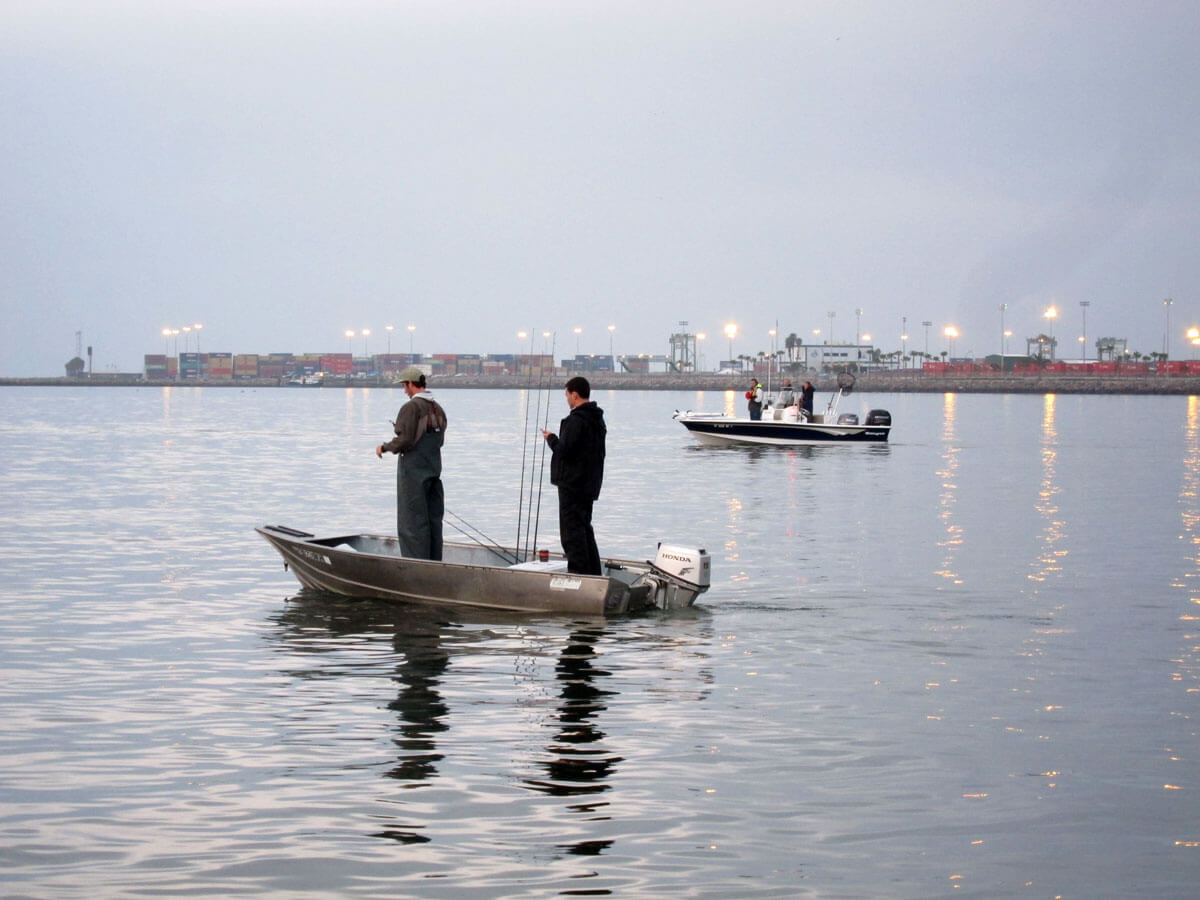Bass Boats Out of Beer Cans
A couple empty beer cans, a few hundred bucks, a weekend of work in the driveway and voila…you’ve got a purpose built paralabrax punisher.
A lot of guys out there own aluminum boats and find themselves applying bass fishing techniques like flipping’, pitchin’ and casting more often than trolling or anchoring up. For these guys, the three-bench seat layout of your standard aluminum boat is not the most functional design. Sure, you could go out and buy a legit bass boat for thousands dollars, but you would have done that in the first place if you could have afforded it, so what do you do? Build one out of your aluminum boat, of course. Building an affordable boat for bassin’ is easier and cheaper than one might think.
Design
The first step in building your new boat is to think about what you need. Draw up a sketch of the boat and add the new decks. Once this is done, decide where to place seating/leaning posts, storage areas, electronics, etc.…. Make several designs and take into consideration access to safety equipment, especially at night. Also, remember to properly displace weight such as batteries, live wells, and fuel tanks. When a design is finally chosen, make a list of the parts you need and order the things that can’t be purchased locally. Items that come to mind here are carpet or vinyl floor covering, rod holders, access hatches, and storage boxes.
Strip It Down
Once a design has been chosen and the parts have been ordered, it’s time to strip the boat bare. If your boat already has a nice finish on the inside, skip the stripping and painting and go straight to making the decks; however, if you own an older boat that has peeling paint and rusty hardware, remove everything. Do not leave one screw that needs to be replaced. If you are going through all the trouble to renovate the boat, you may as well do it right so that it does not need to be done again for several years. Going cheap or trying to take short cuts will only cost more time and money over the years.
When it is entirely stripped, inspect the boat for cracks, and take it to a reputable aluminum welder for any repairs. In this process, make sure to have any additional welding done that may be needed for bow mounted trolling motors, splash guards, seat post supports, additional deck space, or battery holders. The amount you spend here will depend on the amount of customizing you want to do and the condition of your boat. If your boat is structurally sound, proceed to deck building.
Sand, Prime and Paint
Once the boat has been taken down to bare bones, strip the paint from the inside of the boat by applying aircraft paint stripper, which can be purchased at most hardware or paint stores. One 1-quart can is enough to do the job. Working from the front of the boat to the back, apply a thick coat of the stripper with a paintbrush and let it sit until the paint has bubbled. Scrape the paint with a plastic scraper. To make this process clean and efficient, keep some disposable towels and a paper paint bucket nearby to wipe and dispose of the paint and stripper as you go. This process may need to be repeated, depending on the quality and condition of the paint on the hull. After the final coat of stripper has been removed, wash the surface down and let it dry.
The next step in the renovation process is to sand the exposed surfaces so that when the boat is done, the paint will look as is it had been done in the factory. To do this, use a cordless drill with a fiber-polishing disk in the corners and a 3M sanding block to make the flat surfaces smooth. When the surface is ready, spray it with an even, thorough coat of self-etching primer. The final step in this process is to paint the hull with a quality marine paint. This goes for about $60 per gallon, but you’ll only need a quart, so the cost is considerably less, and you can get any color mixed that you want. Roll the paint on with a fine surface roller and then smooth it over with a quality paintbrush. Be sure to brush in one direction, using long, even strokes. This will ensure a smooth finish.
With the hull newly painted, the rebuilding can finally begin. Rewiring the boat will be the most expensive part of the rebuild. Use marine grade wire in the proper gauges for all of your components so they’ll function properly and be energy efficient. Using the previously designed electronics layout, run and install all of the wiring for all of the electronic components. Solder and heat shrink-wrap all of the connection. Taking the time to do this will prevent many problems in the future, especially if you plan on using the boat in a saltwater environment. In addition to making quality connections, take the time to properly route all of the wiring so that it does not rub on sharp metal surfaces, which may cause a short later down the line. To aid in this process, use silicon to encapsulate wires where there may be any chance of vibration causing chaffing. Finally, cover the wire with conduit for a clean appearance and secure it with stainless steel hardware where possible.
Adding Decks
The boat is now painted and rewired, so it’s time to get down to making the decks. Find the centerline of the boat and measure out to the side of the boat every inch until you’ve measured the entire deck area to be installed.. Make sure the decks do not push on the hull of the boat. If this occurs, the pressure will break the support welds of the boat, and the structural integrity of the hull will be compromised. After measuring and drawing out the plans, mark out the area on ¾” exterior grade plywood. Don’t spend the extra money on marine-grade plywood. Proper painting and priming will protect the wood well enough. Next, cut out all of the pieces with a skill saw and a jigsaw. Be sure to bevel the edge of the decking so that you get a clean fit. Once all of the pieces have been cut and mocked-up to ensure a proper fit, cut all access hatches and doors. Then, prime all of the surfaces with a quality wood primer. This will add life to the decks and provide an even surface for adhering the carpet or vinyl in a later step. The last step is to attach the new decks to the old seats and/or structural supports.
Priming both surfaces of your new decks before installation will not only help with the adhesion of your chosen surface material but will also improve their durability.
Adding Carpet
Carpeting the decks is a very easy way to achieve that freshwater bass boat look. In order to carpet the decks, buy enough outdoor or boat carpet to cover the entire deck area. Lay out each deck and cut the carpet so that it is long enough to tuck under the edges of the wood. Cover the entire wood surface with M3 Spray Adhesive. Be sure to line up the fabric so that the pattern is straight, and lay the fabric evenly on the wood. Smooth it out so that there are no air pockets, and once this is done, staple the underside in an even row with corrosion resistant staples. Take the time to make clean corners so that the doors look good when they are opened.
Adding Vinyl
If the boat is going to be used in the saltwater or wet weather, vinyl decking is a better choice. Installing vinyl requires a lot more work, but the end result is a boat that is easy to wash down and does not retain any water, both great features for a saltwater boat. To install the vinyl covering, cover each piece vinyl and wood with a coat of M3 Spray Adhesive. Beginning on the longest edge of the wood, line-up and lay the leading edge of the vinyl. Use a heavy rolling pin or any other heavy round object to smooth the vinyl as you lay it down. Affix the edges with stainless steel staples, and let the adhesive dry completely. Once the adhesive is cured, trim the remaining edges with a razor blade.
After the vinyl flooring has cured, it’s time to begin the final touches. This means adding aluminum trim to all of the exposed edges in order to ensure clean lines and a finished look. Measure and cut ½” angle aluminum to all of the exterior edges of the new decking. Use 2” angle aluminum to cover the front edge of the rear seat and the rear edge of the front deck, and use 2′ flat aluminum to cover all of the horizontal seams. To attach theses aluminum pieces, countersink the holes, coat the undersides of the aluminum with clear adhesive silicone, and use ( #4) 1/2” SS wood screws. The final step is to add all of the hinges and electronics. Pre-drill and silicone all screw holes, and use only stainless steel screws. With this step done, the project is complete.
Approximated Cost of Renovation Without Welding
- 1-Quart Paint Stripper: $10
- 2 Cans of Self-etching Primer: $20
- 1 Quart of Marine Paint: $20
- 2 4X8 Sheets of Exterior Grade Plywood: $80
- 1 Gallon of Wood Primer: $20
- Outdoor Carpet $ 40 or Vinyl Flooring: $90
- Aluminum Trim: $30
- 2 Cans of 3M Spray Adhesive: $20
- Stainless Hardware:$20
- Electrical – Wiring/Fuse Box: $100
- Miscellaneous supplies: $20
- Total Cost with Carpeted Floors: $350.00
- Total Cost with Vinyl Floors: $430.00
The whole point of rebuilding your aluminum boat is to build purpose built fishing machine at an affordable price. To keep the cost down, purchase most of the products at your local hardware or home improvement store. The wiring, however, should be tinned wire, which can be bought at a marine supply shop. This type wire is more corrosion resistant than the regular copper wire you’ll find at a home improvement center. As far as flooring goes, unless you go with the carpet, you’ll need to order the vinyl from an on-line resource. Take into account that this will take a week or two and plan your time accordingly. This whole project, if well planned, can be done in a few days.
See ya’, CB
















Got something to say?